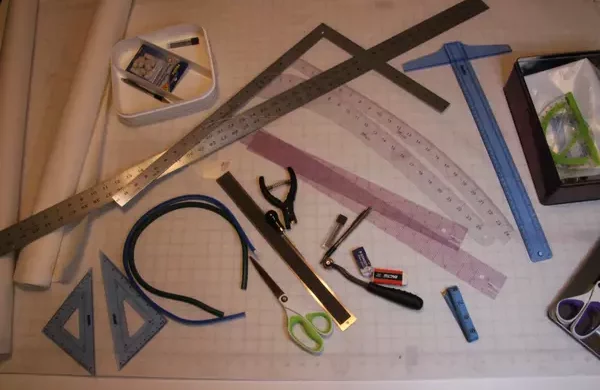
Updating Pattern Drafting Tools
Updating pattern-making tools for Ecclesiastical Sewing projects. New additions include wide paper rolls (48″ and 24″), curved rulers, triangles, and a flexible curve for those tricky curves.

Updating pattern-making tools for Ecclesiastical Sewing projects. New additions include wide paper rolls (48″ and 24″), curved rulers, triangles, and a flexible curve for those tricky curves.
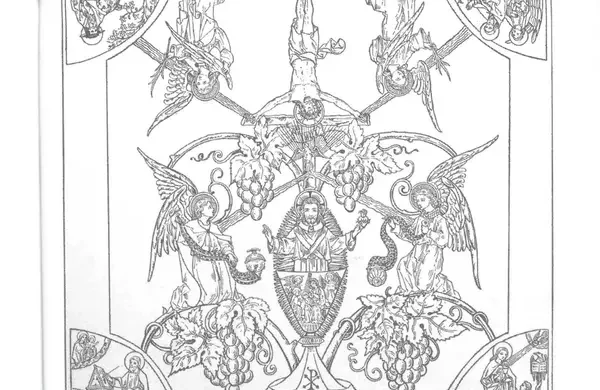
Alethea Wiel, a skilled Ecclesiastical Artisan from 1894, designed a Chalice Veil rich in symbolism. The illustration includes a chalice on seven rocks representing the Seven Sacraments, with the Nativity engraved on the chalice. Angels, Luke, and John surround Christ, while the reverse side showcased the Crucifixion with angels shielding their eyes. A vine, symbolizing Christ, intertwines throughout the design.
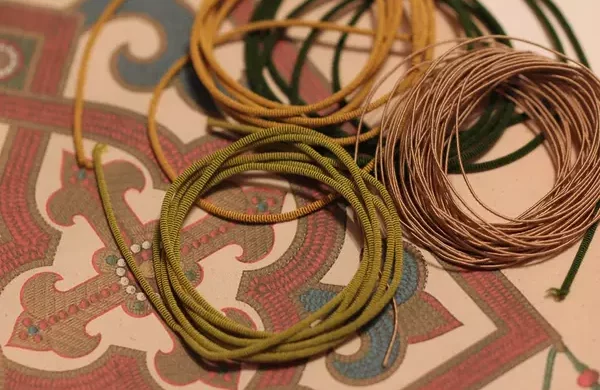
Silk Wrapped Purl and Silk Gimp from Thistle Threads offer exciting possibilities for Ecclesiastical Embroidery projects. Despite their unique qualities, figuring out how to use these threads can be a challenge. Tricia’s blog from The Embroiderer’s Story highlighted the difficulties faced by manufacturers of these specialized threads. To support their survival, an order was placed for Silk Wrapped Purl and Silk Gimp. The Silk Wrapped Purl, neatly packaged in one-yard lengths, possesses a playful, flexible nature. The Silk Gimp, a versatile thread, can be used for outlines, fillings, or couching, providing endless creative options for Ecclesiastical Embroidery projects.

Ecclesiastical Sewing and embroidery elevate pieces through simple details. Inspiration comes from various sources, such as photos, sketches, and notes. For instance, a plain green chasuble with goldwork embroidery gains visual appeal with a flowing gold scroll twist along the galloon trim. This detail softens the transition between the large floral motif and the clean galloon line, enhancing the overall design.
Ecclesiastical Sewing, a traditional craft, provides a glimpse into history and tradition. Exploring vestments worldwide on platforms like Pinterest reveals beautiful hand-embroidered pieces from countries like Russia and Ukraine. A document by the Metropolitan Museum of Art explains the differences between Orthodox and Western Church vestments, showcasing the Russian Phelonion. The ornate vestments from 1802 to 1877 feature luxurious materials, gold, silver, bells, and unique garment labels, offering insight into the rich history of ecclesiastical textiles.

Tips and techniques that can make goldwork progress
– IHS Ecclesiastical Embroidery Design for a Rose Vestment Set. Using the couching technique, she starts with horizontal and vertical rows, opting for a turn-one, plunge-one method to manage thread ends. The needle is placed between gold threads, angled under the previous row, and pulled tight. The chosen couching style creates a brick pattern with alternating stitch placement…
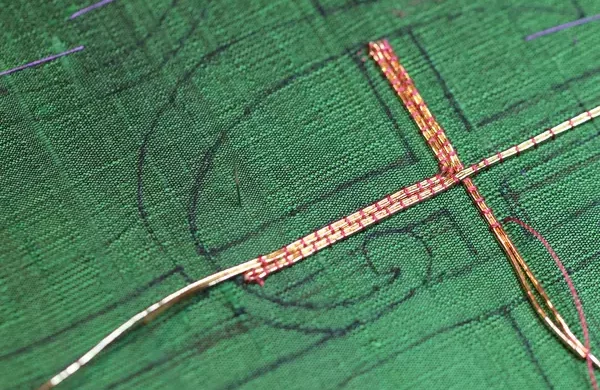
At the start of the goldwork embroidery project, there were some issues. The gold threads got stuck and wouldn’t go through as planned. Despite trying different things, they just wouldn’t cooperate. The problem was found—it was the muslin backing causing entanglement between layers. So, the decision was made to start over. The silk dupioni was securely attached to the Alba Maxima Linen, allowing for corrections. This time, the plan is to stitch from the center outward, hoping for a smoother process.
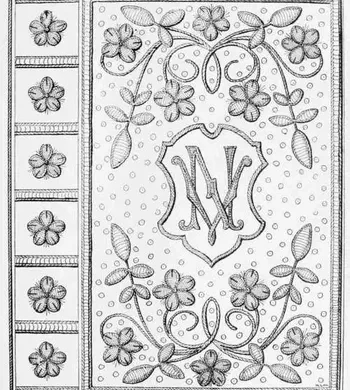
Ella Rodman Church’s 1886 book “Artistic Embroidery” offers valuable insights into color theory and embroidery techniques. Focusing on Ecclesiastical Embroidery, the book explores the proper arrangement of colors and provides advice on pairings and placements. It also features ideas for creating ornate Bible covers, reflecting the historical significance of design book covers. This vintage resource serves as a treasure for those interested in the art of church embroidery.

In the Agnus Dei Ecclesiastical Embroidery Project, significant progress has been made on the upper sky. Using long-laid stitches and horizontal guide marks, the detailed stitching maintains parallel and straight alignment. Frequent thread changes are necessary due to the 6 1/2″ stitch width, but the process speeds up as intricate details around the cross are left behind. The joy of completing a major portion of the sky-laid work is evident, with two-thirds now finished.

Historical monk habit pattern from an old pattern book and recreating the pattern.

The update on the larger of the Agnus Dei pieces’ from The Tale of Two Lambs.
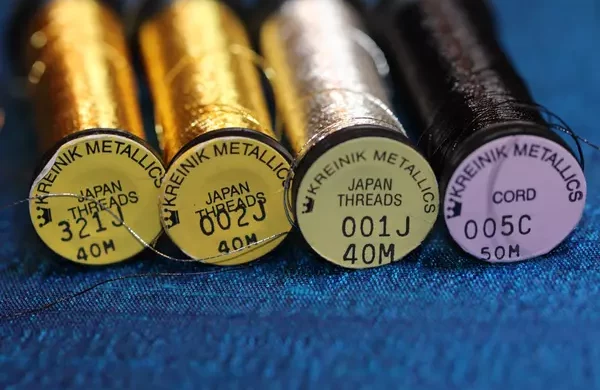
The Beauty of the Art of Ecclesiastical Embroidery and the Ecclesiastical Vestments created from embroidery have a long history with the church. Workers, artisans, craftsmen, both men and women, professional embroidered, and laity, over countless millennia, have added beauty to the church with the work of their hands by creating vestments and hangings for use in the worship service.
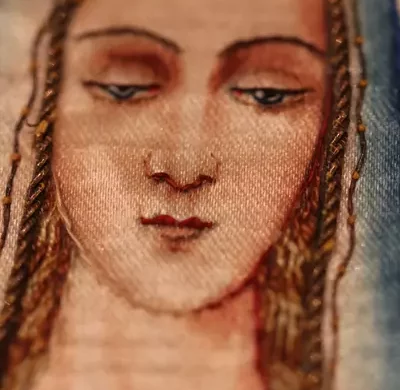
A trip to the Ursuline Center to explore interested items related to Ecclesiastical Embroidery and Vestments. The travel included stops at the Museum and the artist tower, and discovered a collection of hand-embroidered pieces and a few Ecclesiastical Banners that were hand-painted.
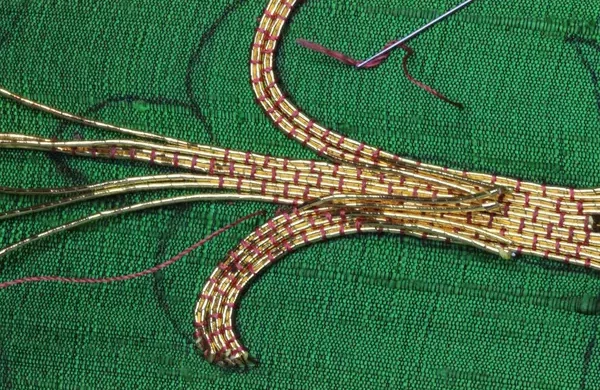
Working on the IHS Ecclesiastical Embroidery with gold threads is exciting. The sparkle and shine bring joy, but dealing with the cross ends is a bit tricky. Inspired by a vintage banner, branching gold threads from the center and facing challenges with plunging through three fabric layers. Considering adjustment for the better results. Happy stitching dreams!
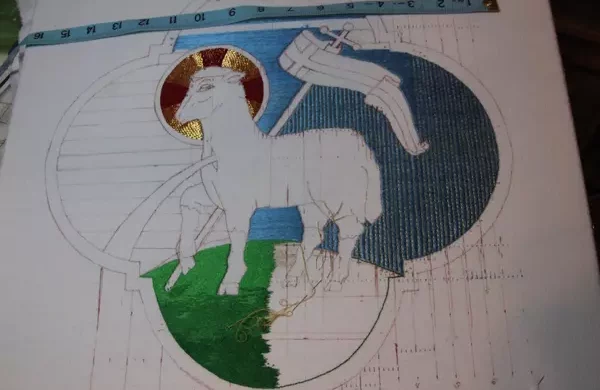
The Ecclesiastical Embroidery Design for the Altar Frontal features the largest Lamb, measuring about 15″ in width. The sky is stitched in Royal Floss, a vivid blue from the Belding Brothers Company. Goldwork details use #4 Smooth Passing with Silk Core from Access Commodities. The design aims for a bright and radiant sky, symbolizing the glorious Resurrection.
You must be logged in to post a comment.